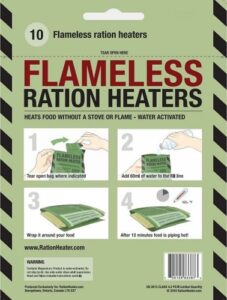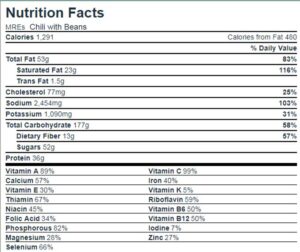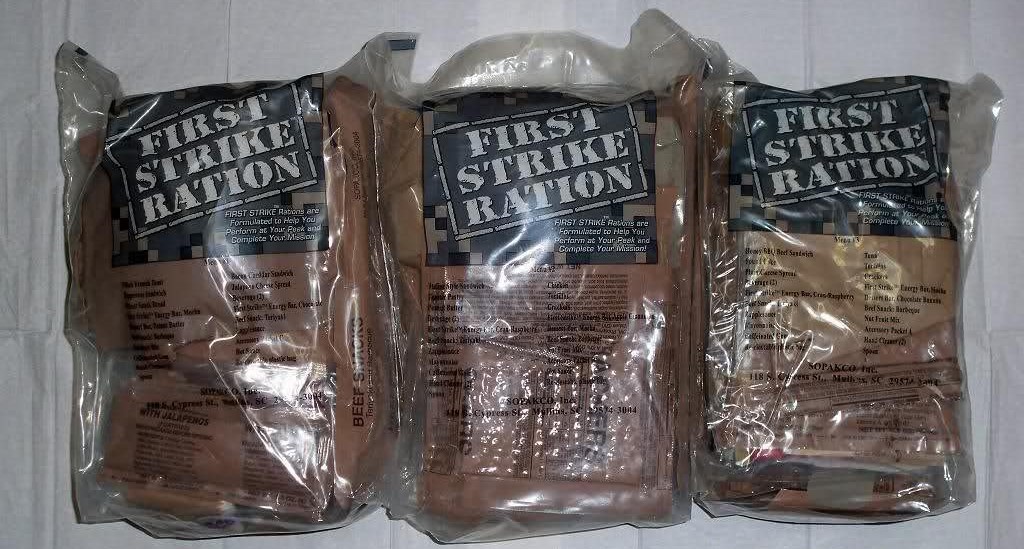What is MRE?
Meal, Ready-to-Eat (MRE) was first developed by the Department of Defense in 1963 to create a lighter self-contained ration as a replacement for the canned Mean, Combat, Individual ration. Today, these MREs are also used to provide civilians nutrients and emergency food during natural disasters. An MRE typically provides 1,200 calories per meal, broken down as 13% protein, 34% fat and 53% carbs. The pre-cooked meals are intended to be used for a maximum of 21 days as the military or civilians are expected to receive fresh food rations within that period.
MREs usually come package in cases with 12 MREs per case. One MRE contains a main course, side dish, dessert, crackers, spread of cheese, powdered beverage mix, utensils such as a plastic spoon, beverage mixing bag and an accessory pack of chewing gum, napkin, seasonings, including salt, pepper and sugar and freeze-dried coffee powder.
In this guide, I will be going through what are the criteria when selecting your MRE and a comparison between military and civilian MREs. Check out my in-depth guide on the best MREs to buy here.
How are MREs prepared?
MREs are stored in a tri-laminate retort pouch which are essentially made out of thick aluminium foil and plastic layers. In the factory, these MRE pouches are filled with food, sealed and then boiled to kill all bacteria. Since the pouch is flat, it requires less time to heat up the food hence preserving the taste of the content. Compared to canned product, a flat pouch only requires 45 minutes versus four hours in a can to kill bacteria. This makes a big difference both to production cost and quality of food. Packaging of an MRE is designed to withstand rough conditions and non-parachute drops of 30 metres. The pouch is light, flexible and flat making it easy to carry in a backpack.
MREs are known to have at least 3 years of shelf life and could go up to more than 5 years of storage life depending on the storage conditions. Generally, an MRE does not require water to eat, but you will need a small amount of water to activate the flameless ration heater to heat up the meal.
Of course, you can prepare your own MREs as well. You can check out our article on DIY MREs to stockpile today.
What to look out for when choosing an MRE
There are several important factors that you need to consider before purchasing the MRE
1. Packing and inspection date

Since MREs does not provide an expiration date, you should find that the MREs are stamped with a four-digit “Julian Code” representing the packing date. The first digit represents the most recent year, and the remaining three digits are the day of the year. For example, 5123 would mean the 123rd day of 2015, or May 3, 2015. To ease the Julian data calculation, use this calculator here.
Also read: How long do MREs last?
The inspection date here indicates the first date that the MRE will need to be checked, usually after three years of packing date. This is not the expiration date but it usually means that the MRE would last for another 3 to 5 years after the inspection date if stored under 75 degrees.
2. Availability of Ration Heaters

I would recommend getting MREs with flameless ration heater so that you could enjoy a warm meal preventing any possibility of indigestion during an emergency or when bugging out. The military specifications for the heater require it be capable of raising the temperature of an 8-ounce entrée by 100°F in twelve minutes.
How to use a ration heater?
- Assemble your MRE, heater sleeve and water
- Remove the meal pouch from the carton
- Tear off the top of the heater sleeve and place the meal pouch into the sleeve
- Pour water into the heater sleeve until the fill line
- Fold the top of the heater sleeve over the top of the meal pouch and place it into the carton
- Place the carton on an incline so that the water does not leak out
- After 10 to 12 minutes, remove the heater sleeve and voila, your MRE is hot and ready to eat
3. Nutritional Value

All MREs are designed to provide at least 1,200 calories per meal with 13% protein, 34% fat, 53% carbs and one-third of the Military Recommended Daily Allowance of vitamins and minerals. Each case will come with 12 menus of different variety and taste to suit your liking. However, it is not encouraged to take MREs for more than 21 days due to its high carbohydrate and fats content which would cause substantial weight gain.
Military vs Civilian MREs
There are no significant difference between the military and civilian MREs. You may find that military MREs focuses on the functionality of the content rather than the packaging. The military MREs package will be stamped with terms like “For military personnel and are not for resale” to discourage people from reselling these MREs on the open market while civilian MREs are going to have the company’s logo, address and appealing packaging.
In a military MRE, the accessories pack might contain additional Tabasco sauce, toilet paper and a piece of chewing gum compared to the normal civilian MRE. In fact, you might not even notice there’s any difference between the military and civilian MRE when consuming the entrée, snacks and beverages.
Best Military Meal Ready-to-Eats
There are three major manufacturers for military MRE namely Ameriqual, Sopakco and Wornick. Each of these manufacturers produces a civilian MRE equivalent with different brand names as shown below.
Ameriqual Apack

Based in Evansville, Indiana, Ameriqual had been a US military food supplier for the past 30 years, they also provide global humanitarian and disasters relief rations. Their design and food manufacturing capability include contract manufacturing, private label, disaster relief and military. Visit this link if you would like to learn more about the company.
The civilian version of the MRE is called Ameriqual Apack MRE which contains 33% less sodium than its competitors. Alternatively, you can opt for their delicious first strike ration (FSR). First Strike Ration (FSR) is a compact, eat-on-the-move assault ration designed for short durations of highly mobile and high-intensity combat operations. The choice between MRE and FSR is really between quality and mobility. MREs taste better but FSRs are more convenient and easy to carry.

That is why you might find that the FSR weighs lighter and in cubes to increase nutrition intake. The net weight per case is approximately 29 lbs. and the cube per case is .99. One FSR provides sufficient food for an entire day with 2,850 calories per meal.
Sopakco SurePack

Based in Mullins, South Carolina, Sopakco was founded in 1943 with over 70 years of experience in supplying processed food to the US military. You can visit their official website here to learn about the company’s capabilities.
Sopakco supplies MREs to civilians through the brand called Sure-Pak meal. Sure-Pak 12 Meals are ready-to-eat food rations. Shelf-stable and waterproof, Sure-Pak 12 Meals are great choice for emergency preparedness, outdoor enthusiasts, or military training. Each pack contains an entrée, side dish, desserts, bread, jam spread, beverage, utensils, condiments, coffee and towelette.
In addition, Sopakco also sells vegetarian meal case that includes 12 complete vegetarian meals with sides, desserts and heaters. The vegetarian menu contains the following entrées: Vegetable Barley Stew, Cheese Tortellini, Lentil Stew or Vegetable Lasagna.

Wornick EverSafe

The Wornick Company is founded in 1979, they also manufacture MREs for civilians and are based in Blue Ash, Ohio. After company’s bankruptcy declaration and restructuring in 2008, they released a civilian MRE brand called EverSafe.
EverSafe MREs are designed with a self-heating unit and portable packaging. The menu has an entrée of either beef, pork, chicken, tuna or vegetarian, a cracker or flour tortillas as well as a single beverage fruit flavoured drink mix to quench your thirst. Similar to other MREs, EverSafe also provides snacks, spread, dining pack such as spoon, coffee, creamer towel, napkin and pepper seasoning.

An EverSafe MRE meal gives you 1,000 to 1,250 calorie per meal with a shelf life of 36 months when stored at 80 degrees Fahrenheit. Unfortunately, Wornick Eversafe is only sold in full pallet quantities currently. 1 pallet usually equates to 48 boxes with 12 meals per box translating to 576 meals. You can only obtain their MRE via the official website contact.
Conclusion
Each major military MRE manufacturer produces a civilian MRE equivalent for the mass market. There is also a multitude of private labels manufacturing their own MREs to the civilian market. Personally, I prefer products from Ameriqual and Sopakco due to their quality assurance and guaranteed taste. MREs are great when you are on the go especially during emergency situations where cooking is not an option.
Let me know in the comments below which MRE brand that you have come across to be reliable and tasty so that I can update the list I have made above!

